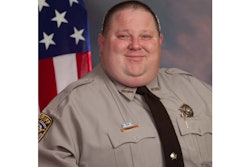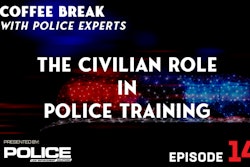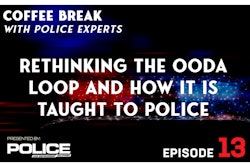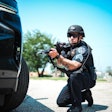![[|CREDIT|]](https://img.policemag.com/files/base/bobit/publicsafety/image/2022/07/pm.techniques_01.jpg?auto=format%2Ccompress&fit=max&q=70&w=400)
Depending upon which source you reference, between half and three-quarters of all officer-involved shootings take place in low-light or altered-light conditions. After all, bad guys tend to lurk in the shadows, and good guys tend to look for them in different degrees of darkness. While time of day certainly has some bearing on this, many “daytime” shootings occur in darkened rooms with insufficient indoor lighting.
Even when a nighttime incident occurs in ambient light—such as halogen street lamps, neon storefront signs, and other area illumination—deep purple shadows conceal hands, faces, and other features that may mean the difference between life and death of everyoneconcerned.
Consequently, many law enforcement agencies have begun to adopt weapon-mounted lights (WMLs) to help enhance officers’ decision-making abilities in sub-optimal lighting conditions. Major gun makers like Glock, Smith & Wesson, SIG Sauer, and others have quickly added rails to the underside of their weapons’ frames to accommodate mounted lights from Streamlight, SureFire, and others.
This is all well and good—it’s another example of the natural evolution of equipment designed to meet the complex demands of policing in the 21st Century.
If we’re to believe that the majority of police shootings take place in some degree of diminished light and acknowledge that weapon-mounted lights are nearing ubiquity in American law enforcement, it’s critical to highlight the importance of low-light training with—and without—these devices.
Addressing the Problem
For starters, we must ask and answer the question, “How much emphasis is currently placed on firearms training in low-light conditions?”
For most agencies, the short answer is probably, “Not enough.”
Dick Fairburn—a public safety professional with more than 46 years of experience and author of the book “Building a Better Gunfighter”—says, “Low-light live-fire training isn’t a thing of the past, but it’s done very little. We used to do it religiously. We used to do it at least once a year. We would shoot using only the headlights. We would shoot only with the red lights on the car, you know, rotating and flashing, which creates sort of a stroboscopic thing, which can throw people off. I’m not sure if some agencies are doing any of that training at all.”
Don Alwes—a 36-year veteran of law enforcement who now trains law enforcement officers around the country—says that police trainers must teach officers four basic things in low light.
“They need to be able to navigate in low light and a weapon-mounted light is not for navigating—that’s what a handheld light is for,” Alwes says. “They have to be able to locate things in low light and they have to be able to identify what they’ve found—is this a threat or not? They need to be able to engage against a threat. That may mean lethal force. It may mean less-lethal. It may be going hands-on or simply verbal. They need to be able to do all that, and a weapon-mounted light is intended only for engaging with lethal force.”
Todd Fletcher—a retired law enforcement officer with more than 25 years on the job and now co-owner and lead instructor for Combative Firearms Training LLC—agrees.
“You need to train to use the weapon-mounted lights for shooting and handheld lights for everything else,” Fletcher says. “You need to make sure that those skills are repeatable, taking those skills from the square range training environment and building those skills to the scenario training environment, where you’re training and testing those skills to make sure that they’re repeatable under a variety of stress conditions.”
If we accept the conclusion that more training for high-stress, rapidly unfolding, potentially deadly encounters in low light must be enhanced and increased, the question then becomes, “How?”
Resolving the Problem
For a variety of reasons, most law enforcement firearms training—from the academy on—takes place on a square range in broad daylight. First and foremost among those reasons is the fact that live-fire training in the dark requires an almost unmanageable trainer to trainee ratio, which can quickly become prohibitively expensive.
Further, many departments do not have access to an indoor range where lighting conditions can be completely controlled—firearms trainers are instead relegated to an outdoor facility well within earshot of nearby residents who tend to get a little cranky when the range remains hot after sundown.
That’s when it’s time to go inside.
Alwes, Fairburn, and Fletcher each point out that scenario-based training with inert weapons and role-players as well as use-of-force simulators can significantly enhance low-light training.
Utilizing Simunitions and airsoft in reality-based training amplifies the stress levels and provides a better measurement of teamwork and team movement—as opposed to just poking holes in paper—and can significantly enhance confidence of officers during real-world incidents.
Use-of-force simulators can help in developing decision-making skills that are crucial in real-world confrontations in low-light settings where mistakes of fact and judgment can lead to tragedy.
Simulators are an excellent tool to enhance the training done on the square range and in training with inert munitions because they allow participants to practice all of levels of force—from verbal de-escalation to lethal or deadly force—in a wide range of light settings controlled by the instructor’s input into the computer.
Simulators can also be effective at ensuring that the skills acquired in all phases of an officer’s training are adherent to current policies and procedures. Trainers can stop a scenario, explain what could or should be corrected, and either restart or resume the training to reinforce the tactics they are trying to teach.
However, trainers in this environment must remain vigilant that they use simulator technology as a teaching tool, not a testing tool. Trainees must not be penalized for making “mistakes” because it is from those errors in the simulator that they are most likely to adapt their tactics to the desired result—given the opportunity to do so.
Different Tools
Alwes, Fairburn, and Fletcher agree also that training must include a substantial amount of work with handheld lights in addition to those mounted to the gun. They also concur that this training must include a variety of handheld techniques—from Harries to Rogers to Chapman to Neck-Index to ‘FBI’—in order for officers to be prepared to illuminate a threat when their WML goes down.
“I’m reminded of the old military adage, ‘two is one and one is none’—you can’t just rely on one technique,” Alwes says. “Different techniques all have an application depending on the tactical circumstances. The FBI Technique can be useful in certain types of cover, for example, where you can put the light out on one side of the cover and have the weapon ready to engage on the other side. An instructor needs to be conversant in a whole variety of techniques, and someone who’s not an instructor needs to know at least a couple.”
Finally, Fairburn offers the reminder that trainers should maximize on whatever indoor range availability they might have access in their area.
“For the agencies that have access to an indoor range and don’t do low-light firing, shame on them because you can control the lighting inside that range,” Fairburn says. “You can do it 24 hours a day—you can simulate those kinds of low-light conditions.”
Finally, trainers must continually emphasize the importance of utilizing the right light at the right time.
Agency administrators and attorneys get plenty agitated when a video comes to their attention showing an officer utilizing a weapon mounted light for anything other than threat assessment in an armed encounter.
Altogether too many videos are floating around the Internet showing officers using weapon-mounted lights to illuminate things that clearly offer no imminent threat—everything from a driver license in the officer’s support-side hand to an innocent civilian cowering in a darkened corner during a building search.
It must be taken into account that there are circumstances when using a weapon-mounted light is the only viable option. Consider this hypothetical:
Officers are in a vehicle pursuit of a wanted felony suspect in the bright sunlight of early afternoon.
The subject crashes and comes to a stop, bails out of the crumpled car, and flees on foot into an abandoned and darkened building.
Knowing that the subject is potentially armed and dangerous, pursuing officers follow in an effort to take the suspect into custody.
The danger and exigency of this scenario could dictate that the best lights at the moment are the ones mounted to the officers’ pistols.
That possibility being accounted for, trainers must emphasize the importance of training with handheld lights—leaving the weapon lights for their intended purpose.
Fairburn says, “I haven’t seen a lot of misuse of weapon lights, but the potential is there. If you’re searching a building and have your gun out, I don’t have a big problem with using the weapon mounted light for that search, but checking out a driver’s license or something like that—that’s, that’s a bozo no-no.”
Fletcher says, “If the gun is pointed at a threat, you can have your weapon light on and pointed at the threat. The rest of the time to locate and navigate at night or in low light conditions you’re using a handheld light. To do otherwise violates one of the Cardinal rules of firearm safety—don’t point your gun at anything you’re not willing to shoot.”
Alwes adds, “It is incumbent on our trainers to include handheld lights in training even if you have the best weapon-mounted lights in the world because there are just so many other functions that need to be done—functions that require the use of handheld lights.”
Weapon-mounted lights are an excellent way to improve an officer’s marksmanship in low-light situations. The weapon-mounted light not only makes the target more clearly visible, but it frees up the support side hand to improve the stability of the gun.
Weapon-mounted lights also are instrumental in mitigating misidentification of threat level due to impaired visual acuity in low-light conditions and thus probably contribute to a reduction in mistake-of-fact shootings.
Lowering the instances of such “bad” shootings should—at least in theory and on paper—lead to fewer lawsuits levied against police departments. Fewer lawsuits might mean less financial hemorrhaging in settlement payouts.
If we accept the conclusion that law enforcement agencies conduct training on a regular basis and that a significant portion of that training involves live-fire, reality-based role-player, and simulator training, it stands to reason that a greater emphasis could and should be placed on operations in low-light conditions.
Doug Wyllie is contributing web editor for POLICE.
















